I admit it. I did not enjoy science and math very much when I was a kid. But new and fresh approaches in books for young readers (and I, of course, am still a young reader at heart) are sure to not only engage but inspire a new generation. Many new books are sure add to an appreciation of the humanities.
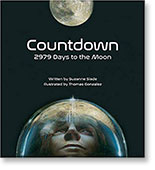
Countdown: 2979 Days to the Moon (Peachtree) is the story of the moon landing almost 50 years ago. The subtitle refers to the time between President John F. Kennedy’s speech articulating his dream of putting a man on the moon and the successful moon landing. It is written in compelling verse punctuated by relevant quotes, additional information about the Apollo astronauts and extended by sometimes photorealistic paintings. Sources used for quotes, photographs and “More About Team Apollo” create not only a fine piece of nonfiction but a handsome and memorable look at science and technology, tenacity and teamwork.
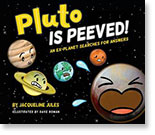
Humor is the hallmark of Pluto is Peeved: An Ex-Planet Searches for Answers (Seagrass Press). As the title indicates, little Pluto, a cartoon character in an easy graphic format, is unhappy about his demotion. As he explores the reasons, he talks to a huge creature (formerly known as the brontosaurus), the tiniest (germs), and even a rock. Sounds silly but it works in as it’s appropriately presented as a comic book. There’s serious information, however, and motivation to continue exploring the topics. All ends well for Pluto, of course; he discovers that he has other dwarf planet siblings. Back matter includes a more serious examination of each subject introduced.
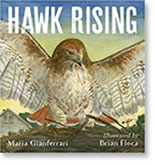
Closer to home, Hawk Rising (Roaring Brook) and A Frog’s Life (Holiday House) introduce animals of the air and water. We share the experience with a mother and daughter as they watch a red tail hawk search for food for his hungry offspring. (Beware; a squirrel is caught to become dinner, dramatic though not gory.)
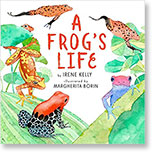
Frogs, too, eat other creatures and are sometimes eaten, all a part of A Frog’s Life . Frogs are colorful, live in all climates, and presented in brief, informative text. Both Hawk and Frog are illustrated in dramatic, elegant, and accurate watercolor illustrations. Both include references. Both are sure to capture young readers.
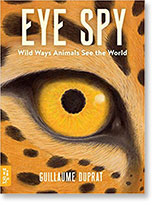
Hawks are raptors just like eagles are. So not surprisingly, being eagle-eyed is not unlike having a hawk-eye. If you’ve wondered what it’s like to see like an eagle — or why an eagle sees so well — just lift the flap in Eye Spy: Wild Ways Animals See the World (What on Earth Publishing). Readers can glimpse the world through the eyes of an eagle and other birds, as well as the various ways that mammals large and small see, the unique vision of reptiles, amphibians, worms, and mollusks, and even through the complex eyes of insects. And naturally, how humans see is presented. Not only is this attractive book fun, it is informative and downright fascinating.
In a world of sound bites and fleeting images I’ve come to appreciate more than ever the steady presence of well-illustrated, informative books. Even more, I appreciate fresh ways to examine subjects that may be familiar or unfamiliar.
That’s what fresh approaches to STEM subjects in books for young readers achieve. Plus, in word and image they add “art” to STEM to create a STEAM experiences for readers of all ages — including a person who didn’t think she liked science or math.
About the Author
Reading Rockets’ children’s literature expert, Maria Salvadore, brings you into her world as she explores the best ways to use kids’ books both inside — and outside — of the classroom.

